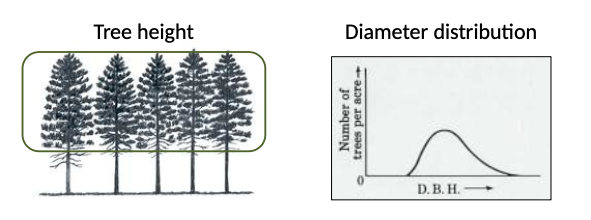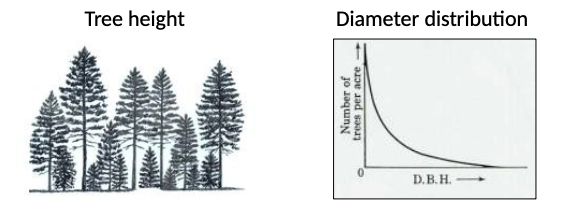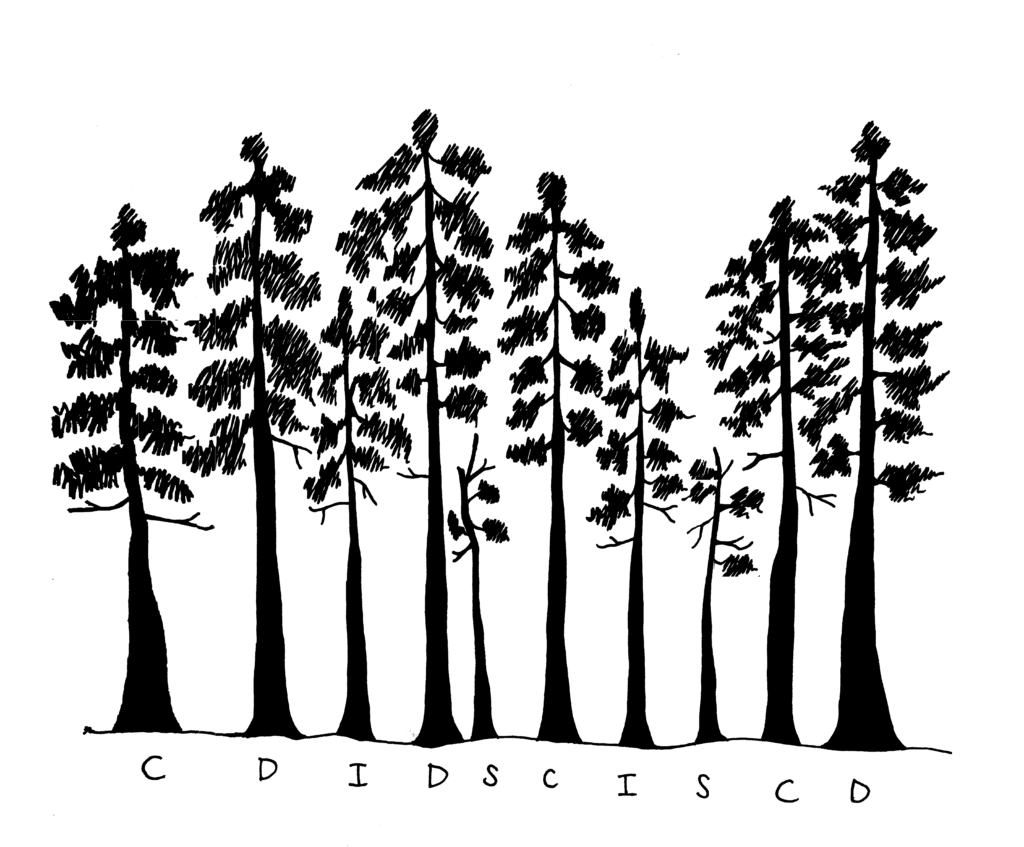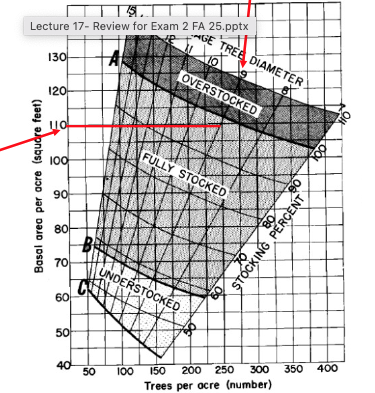Forestry Exam 2
1/86
Earn XP
Description and Tags
Math, Stand Dynamics, Forest Measurements, Silviculture
Name | Mastery | Learn | Test | Matching | Spaced |
|---|
No study sessions yet.
87 Terms
If you are looking at the trees within a plot, what is n?
N=nt=# of trees within the plot
If you are looking at the plots themselves and the estimates (e.g. TPA, BA/ac) at the plot level, what is n?
n=np=# of plots in the sample (inventory)
If you have the DBH of a tree (inches) how do you calculate basal area (BAt) of that tree in square feet?
BAt=0.005454*(DBH²)
TPA for a fixed area plot:
EFt = Unit Area/Plot Area = reciprocal of fractional plot size = TPAt
TPA for a point sample
EFt = (BAF/BAt) = TPAt
BA/ac for a fixed area plot
BA=0.005454×DBH²
BA/ac for a point sample
𝐵𝐴/𝑎𝑐=Tally×BAF, where Tally is the number of “in” trees
Fire can be a useful landscape management tool to:
reduce undesirable _______
Reduce _______ on the ground
Promote ____________________
Understory species, fuel load, advanced regeneration of desirable species
Thick bark is an adaption to fire T/F
True, Thick bark helps fend off fire damage.
Non-serotinous cones are an adaption to fire T/F
False, Serotinous cones are an adaption to fire
Shallow root systems are an adaptation to fire T/F
False, Deep root systems are an adaptation to fire
Serotinous cones are an adaption to fire T/F
True, serotinous cones are an adaption to fire
Deep root systems are adaptations to fire T/F
True, Deep roots are adaptations to fire
Grass stage until fire disturbance is an adaptation to fire T/F
True, Grass stage until fire disturbances is an adaptation to fire
Primary Succession occurs when…
a previously lifeless surface is first colonized by plants, animals, and fungi
Secondary Succession occurs when…
an existing ecosystem recovers from a disturbance
What is a Pioneer Community?
A species or group of species that came in the first stage of succession following a major disturbance
What is a Climax Community?
A species or group of species that come in later stages of succession and become dominant species
Are these characteristics for a Climax or Pioneer Community?
-Shade Tolerant
-Adapted to handle strong competition
-Advanced regeneration
-Tend to persist underneath a canopy of early successional species for a long time
Climax Community characteristics
Are these characteristics of a Climax or Pioneer Community?
-Shade Intolerant
-Adapted to harsh conditions
-Seed in easily
-Tend to inhibit growth of other species
Pioneer Community Characteristics
Stand Dynamics are…
The study of changes in forest stand structure and composition with time, including ____ behavior after disturbances and the growth/development of ALL vegetation in the ____
Why do we use Stand Dynamics?
-Temporal variation in forest stands is inevitable
-Understanding such changes allows the silviculturalist to make predictions for future conditions
Stand descriptions are used to…
characterize the structure and stage of stand developments
What is Stand Description based on?
Species composition, Stand age structure
What is Regeneration Disturbance?
Uproar events that kill some or all trees in a stand and result in increased growing space for new individuals
Bottom-up disturbance
Disturbance Events that can affect all vegetation in the stand, including small and large trees.
Top-down disturbance
Disturbance events that commonly affect large trees more than small trees, often releasing small trees after the disturbance
Single-cohort stand:
All trees in the sand are in the same cohort (even-aged)
Double-cohort stand:
two cohorts are present in the same stand
Multiple-cohort stand:
At least three cohorts are present in the same stand (uneven-aged)
Pure stands:
composed principally of one species, typically at least 80%, based on #, basal area, or volume
Mixed-species stands
composed of two or more prominent species (none which has >80% abundance)
Stand structure:
the horizontal and vertical distribution of components of a forest stand, including the height, diameter, crown layers, and stems of trees/shrubs/herbaceous understory/snags/down wood debris.
Characteristics of Even-aged, pure stands
One canopy stratum
Normal diameter distribution
Height is often used to identify trees of the SAME SPECIES in the same cohort
Characteristics of Uneven-aged, pure stands
Multiple canopy strate
‘Reverse-J’ diameter distribution
Height is often used to identify trees of the SAME SPECIES in the same cohort
Is this an Even or Uneven aged pure stand?

Even
Is this an Even or Uneven aged pure stand?

Uneven
What are the 4 developmental stages of cohorts of trees?
Stand initiation
Stem exclusion
Understory re-initiation
Old-growth
What is step three of stand development and what does it do?
Understory re-initiation, canopy loss creates understory openings for regeneration
What is step two of stand development and what does it do?
Stem exclusion, stage of completion
What is step one of stand development and what does it do?
Stand initiation, establishment
What is step four of stand development and what does it do?
Old-growth, new cohorts gain canopy status and original trees are lost
Dominant trees are:
Trees with crows extending above the level of the crown cover, receiving light from above and partly from the sides
Codominant trees are:
Trees with crowns forming the general level of the crown cover, receiving light from above but little from the sides
Intermediate trees are:
Trees with crowns extending into the crown cover but receiving little light from above and none from the sides
Overtopped (suppressed) trees are:
Trees with crowns entirely below the crown cover, receiving no direct light from above or the sides
From this, which trees are Dominant?

D1 and D2

From this, which trees are Codominant?
C1,2,3

From this, which trees are Intermediate?
I1,2

From this, which trees are Overtopped?
S1,2
Natural pruning occurs when
stand density is high, creating low light for the lower branches.
Natural pruning is…
the removal of branches from individual trees due to biotic and abiotic processes related to the growing environment.
What is Epicormic Branching?
Branching from shoots along the main stem of the tree often brought on by increased light levels
Will Epicormic Branching occur in GREATER stand density or LESSER stand density?
Greater
Stand density will affect both ___________ .
Tree growth and tree form
Tree growth:
Each given site can support the production of a specified amount of carbohydrate for growth.
What is the primary response of individual trees to thinning?
Expansion of the crown into the new growing space
Why does the crown expand as a result of thinning?
Increases the photosynthetic potential, the carbohydrates produced, more carbs available for lower priority growth (diameter growth)
_________ and _____ are measures of stand density expressed as a percentage of the full utilization of the growing space in the stand
Relative stand density, stocking
A Fully Stocked Stand:
Trees occupy all growing space but have room for development
A Overstocked Stand:
Trees have occupied all the growing space in the stand and growth is restricted
A Understocked Stand:
Trees do not use all the available growing space
How can we use TPA, BA, and Volume to manage (thin) the forest?
Measures are used to get an idea of what the site “occupancy” currently is relative to what we would like it to be.
What is Growing Stock?
General term for above stump volume of live trees in the forest stand.
Acceptable Growing Stock (AGS)=
Good timber value
Unacceptable Growing Stock(UGS) =
Poorer quality but might still be sold
Cull =
No value for timber, but may be good for wildlife

Say we have a BA/ac estimate of 90 and a mean DBH of 8 inches, is it Fully, Over, or Understocked? And what stocking level would we have?
Fully stocked, 250 TPA
Geometric Thinning is
primarily present in even-aged stands involving removal of trees in rows, strips, or by fixed spacing intervals
When is Geometric Thinning typically used?
Earlier stages of stand development, between 15-30 years of age for the stand, when site index is moderate-high.
The Dx rule for thinning to B-level stocking:
Mean DBH times 2
The Dx rule for thinning to A-level stocking:
Mean DBH times 1.5
Say you measure total height of a tree using a clinometer. You are 50 ft horizontal distance from the tree and you get a top measure of 75% and a bottom measure of -2%. What is the height of the tree?
38.5 ft
Say you are trying to take a diameter at breast height (DBH) measurement from a tree and accidentally take the measurement at 6 ft off the ground rather than 4.5 ft off the ground. The resulting DBH measurement will most likely be:
Smaller than it should be
A common device for measuring tree diameter at breast height (DBH) is a Biltmore stick T/F
True
When taking a diameter at breast height (DBH) measurement with a Biltmore stick, how far does the stick need to be held away from your eye?
25 in.
If you are measuring tree height with a clinometer and the bottom measurement is a positive number, are you standing:
Downhill from the base of the tree
BA of a tree is calculated using both DBH and tree height.
False
The value used for calculating individual BA is called the Loggers constant.
False, Foresters
You measure a shagbark hickory and get a diameter at breast height (DBH) of 9 in. What is the basal area (BAt) of this tree? Be sure to round your answer up to the nearest 10th (one decimal place) and choose the closest answer.
0.4 ft²
You measure a northern red oak tree and get a diameter at breast height (DBH) of 20 in. What is the basal area (BAt) of this tree? Be sure to round your answer up to the nearest 10th (one decimal place) and choose the closest answer.
2.2 ft²
In the unlikely circumstance that you find a perfectly cylindrical log, which of the log volume formulae will give you an absolutely accurate calculation of volume?
All formulae will give the same answer
Say that you measure the diameter at breast height (DBH) of the large end of a log and get 16 in.. Calculate the cross-sectional area B in square feet, rounded to the nearest 10th (one decimal place).
1.4 ft²
It is common to use random sampling in forest inventory T/F
False
Square plots are the most common fixed area plot shape in forestry T/F
False
When we derive a per acre estimate of the forest attribute (e.g., volume/acre, basal area/acre) our estimate represents:
An “average” estimate of that attribute per acre across the stand
Say that a forester designs a systematic sample for a forest stand that they have been contracted to manage. They decide to just start the sample from the corner of the stand where they usually come in. Which of the following is the biggest problem with this approach?
The sample does not satisfy the randomization assumption